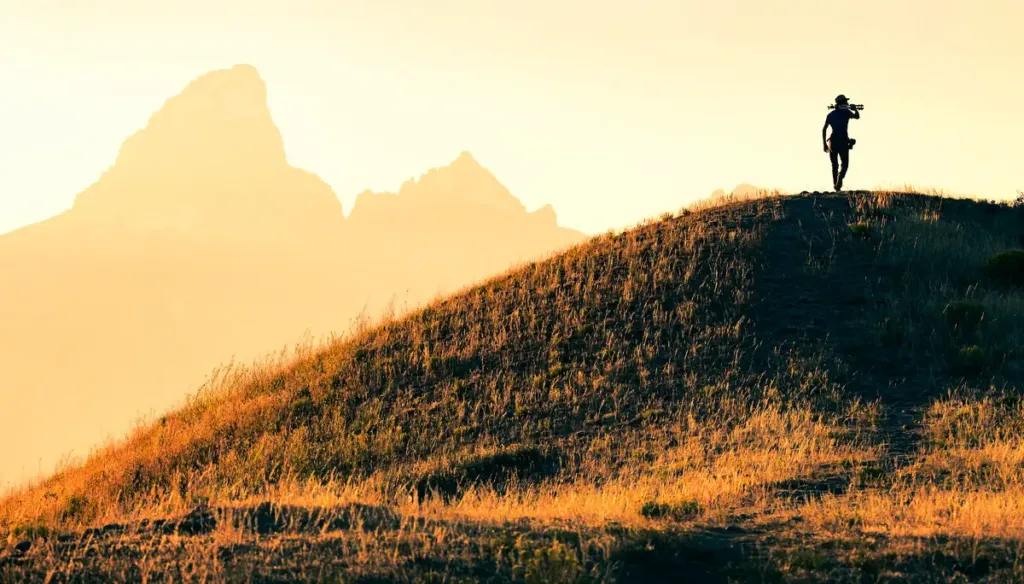Is hiking Cardio or strength training?
This post may contain affiliate links. This means that we may receive a small commission from purchases through those links. Read more in our affiliate disclosure.
Is hiking more about strength or cardio? Now, as a hiker, you’re likely no stranger to the panting and sweating that accompanies a long trail, nor the satisfying burn of your muscles after an uphill battle. However, have you ever wondered which component—strength or cardio—dominates this timeless outdoor activity?
Hiking isn’t a contest between strength and cardio—it’s a harmonious interplay of both. As a comprehensive form of exercise, hiking engages a range of muscles, from your legs and glutes to your arms and core, making it a fantastic strength-building activity. At the same time, the sustained nature of hiking and the effort required, especially on uphill segments, gives your cardiovascular system a substantial workout, enhancing your stamina and fat-burning capacity. So, hiking beautifully combines the benefits of strength training and cardio, offering a balanced, holistic workout that boosts both physical and mental health.

- Introduction
- The Cardio Element
- Cardio and Your Body
- Cardio and Fat-Burning
- How Hiking Stimulates Cardio
- Cardiovascular System Adaptation
- VO2 Max and Hiking
- Hiking at Altitude
- The Strength Element
- The Making of Hikers Legs
- Upper Body Engagement
- Foot Strength
- Maximizing strength gains during recovery
- Bone Health and Hiking
- Addressing Muscle Imbalances
- The Role of Flexibility and Balance
- The Synergy of Strength and Cardio in Hiking
- The Holistic Trail of Hiking
The Cardio Element
Cardio and Your Body
Cardiovascular exercise, often just termed ‘cardio’, is any form of exercise that elevates your heart rate and keeps it elevated for a significant duration. This increase in heart rate is like a workout for your heart muscles, fortifying them and enhancing the efficiency of their blood-pumping mechanism. A robust and efficient cardiovascular system carries a wealth of benefits for overall health—lowered blood pressure, reduced risk of heart disease, improved lung capacity, stress reduction, better sleep, and heightened brain health.
Cardio and Fat-Burning
Now for the crux that interests most folks—the fat-burning aspect. During cardio, your body taps into its reserves of carbohydrates and fats to fuel the activity. The choice of fuel depends on the intensity and duration of the exercise. Lower-intensity activities sustained over a long duration, like hiking, utilize fats as the primary source of energy. This makes hiking an excellent fat-burning workout, ideal for those aiming to maintain or reduce their weight.
I want to address a common misconception here: When you exercise more intensely, “leaving the fat burning zone” so to speak, you don’t burn less fat. No, you burn as much fat as your body is able to. But, at the same time, you also burn more carbohydrates. So, if you’re trying to lose weight, don’t worry about going too fast – if you go beyond the fat burning zone, you burn more energy in total, and lose weight faster!
How Hiking Stimulates Cardio
So how does hiking fit into the cardio equation? Hiking is a staple form of cardiovascular exercise. The challenges of uneven terrains, steep ascents, and long trails push your heart rate up and keep it there for a long duration. The heart rate of an average adult during a hike can reach about 60-70% of their maximum heart rate, similar to a moderate-paced jog or a brisk walk. If you opt to hike up steeper inclines or increase your pace, you’re looking at a heart rate that could reach even higher. If going fast is your thing, check out our guide on ultralight hiking vs fastpacking.
Cardiovascular System Adaptation
Regular hiking isn’t just a momentary stimulus for your cardiovascular system—it leads to lasting changes. Regular hikers might notice that they can handle the same trails with less effort over time. That’s because your heart is getting stronger and more efficient at pumping blood, and your lungs are becoming more adept at oxygen intake and distribution. Essentially, your cardiovascular system adapts to handle the demands of hiking more efficiently.
VO2 Max and Hiking
One crucial metric of cardiovascular fitness is VO2 Max, which represents the maximum amount of oxygen a person can utilize during intense exercise. Higher the VO2 Max, better the cardiovascular fitness, and the farther you can go without getting tired. Hiking, particularly at higher altitudes where oxygen is scarcer, can help improve this metric. As you adapt to the lower oxygen levels, your body becomes more efficient at using the available oxygen, thereby potentially increasing your VO2 Max.
Hiking at Altitude
Speaking of altitude, the effects of high-altitude hiking on the cardiovascular system are fascinating. As you ascend, the air gets thinner, meaning there’s less oxygen available. This puts an extra strain on your cardiovascular system, as it works harder to deliver the necessary oxygen to your working muscles. While this may be challenging, it also serves as an excellent workout for your heart and lungs, enhancing their strength and efficiency even further.
The essence of hiking stretches beyond the basic concept of a long, challenging walk. A hike engages and enhances your cardiovascular health, placing you firmly in that sought-after fat-burning zone.

The Strength Element
Strength, within the confines of fitness, is your body’s capacity to exert force on physical objects, including your own body weight. Strength training involves any exercise that employs resistance to work your muscles. It’s a vital part of overall fitness, aiding in the improvement of muscle strength and endurance, metabolic enhancement, bone and joint fortification, and reduction in injury risk.
The Making of Hikers Legs
When we discuss strength and hiking, it’s impossible to ignore the phenomenon of ‘hikers legs’. This term is often used to describe the muscular, well-built legs that avid hikers usually sport. But what exactly constitutes these ‘hikers legs’? Here’s a list of the key muscles that hiking puts to the test:
- Quadriceps: These muscles at the front of your thigh do the lion’s share of work during steep uphill sections and while pushing off the ground.
- Hamstrings and Calves: These muscles on the back of your thigh and lower leg get a wonderful workout, especially when you’re heading downhill.
- Glutes: Your glutes are the powerhouses of your lower body. Hiking, especially uphill, seriously works your glutes.
- Hip Flexors: These muscles, nestled in your pelvic region, work with your glutes to help lift your knees and propel your legs forward.
Upper Body Engagement
While the legs and glutes are the most obvious benefactors of hiking, it would be wrong to overlook the upper body. Hiking also engages a range of upper body muscles, more so if you’re using trekking poles:
- Arms and Shoulders: These muscles are tasked with planting your poles and pushing off with them, aiding your forward propulsion, particularly uphill.
- Core (Abs, Lower Back, and Obliques): A strong core aids balance and stability on uneven terrains, and it helps transfer power from your upper to your lower body, especially when using trekking poles.
Foot Strength
In typical hiking boots, the muscles of your feet and ankles don’t get engaged very much. However, once you venture into more minimalist footwear such as barefoot sandals, all those small muscles stabilizing your ankles and moving your toes get strengthened, which can really benefit your feet’s balance and stability.
Maximizing strength gains during recovery
Muscles grow not while they are being strained, but while resting after exercising. The process of recovery post-hike is just as important as the hike itself, which we discuss in detail in our guide on how to recover after a hike.
Bone Health and Hiking
An often overlooked benefit of strength training, including hiking, is its impact on bone health. The weight-bearing nature of hiking puts stress on your bones, encouraging them to become denser and stronger. This is particularly crucial for individuals at risk of osteoporosis.
Addressing Muscle Imbalances
While hiking offers a holistic body workout, it does emphasize certain muscle groups more than others. If not addressed, this could lead to muscle imbalances. Off-trail workouts can be beneficial to ensure all muscles are equally strengthened and to prevent any potential injuries.
The Role of Flexibility and Balance
Strength isn’t just about raw muscle power. Flexibility and balance play vital roles in a successful hike. They help you navigate tricky terrains and prevent falls or injuries. Regular hiking can improve these aspects, contributing to your overall fitness levels.
The Synergy of Strength and Cardio in Hiking
When it comes to hiking, the relationship between strength and cardio isn’t a case of either-or. These two facets of fitness don’t operate in isolation. Rather, they complement each other in a beautiful synergy, making hiking a complete and balanced workout.
The Yin and Yang of Fitness
Think of strength and cardio as the yin and yang of fitness, each bringing unique benefits to the table. Cardio works on the engine of your body, your heart, keeping it healthy and efficient. It also ramps up your body’s fat-burning capabilities and builds endurance. On the other hand, strength training beefs up your muscular structure, aids in maintaining a healthy skeletal system, improves your body’s metabolic functions, and sharpens your balance and flexibility.
In hiking, you don’t have to choose between these two. You get the benefits of both in a single activity. The cardiovascular system is continuously engaged throughout your hike, while various muscle groups are worked intensively, especially during uphill and downhill sections.
Building Endurance and Strength
The beauty of hiking lies in how it leverages the synergistic relationship between strength and cardio. As you ascend a hill or trudge along an extended trail, your heart rate increases, and your muscles are constantly engaged. This helps build both cardiovascular endurance and muscle strength simultaneously.
Moreover, as your cardiovascular fitness improves, so does your ability to sustain prolonged physical effort, meaning your muscles can keep working for longer. On the flip side, as your strength improves, you become more efficient in your movements, reducing the cardiovascular effort required to hike the same trail. It’s a feedback loop of improvements.
A Balanced Workout
The symbiosis between strength and cardio in hiking ensures that you get a balanced workout. This balance is crucial not just for your physical health but also for your mental well-being. The cardio aspect of hiking aids in reducing stress and improving mood, while the strength aspect builds confidence and self-esteem.
Furthermore, this balance also reduces the risk of overuse injuries that might stem from focusing too much on one type of exercise at the expense of the other. For instance, excessive cardio without enough strength training can lead to muscle loss, while overdoing strength training without sufficient cardio can lead to decreased heart health.

The Holistic Trail of Hiking
As we’ve journeyed through the landscapes of strength and cardio, it’s clear that the world of hiking doesn’t play favorites. It’s not about leaning heavily on strength or cardio—it’s about both. Hiking offers a cocktail of health benefits derived from both worlds, making it a well-rounded, complete form of physical exercise.
So, to the question, “Is hiking more strength or cardio?” the answer is, “Why choose?” Hiking is an open invitation to everyone, a path that beautifully weaves together the tapestry of strength and cardio, offering a fitness package that’s hard to beat.




